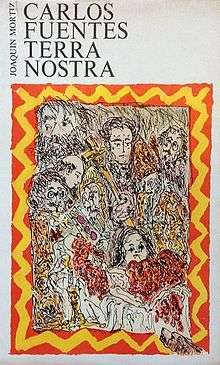Terra Nostra (novel)
 First edition (Mexico) | |
| Author | Carlos Fuentes |
|---|---|
| Translator | Margaret Sayers Peden |
| Country | Mexico |
| Language | Spanish |
| Publisher | Editorial Joaquín Mortiz |
Publication date | 1975 |
Published in English | 1976 |
| Pages | 783 |
Terra Nostra is a 1975 novel by the Mexican writer Carlos Fuentes. The narrative covers 20 centuries of European and American culture, and prominently features the construction of El Escorial by Philip II. The title is Latin for "Our earth". The novel received the Xavier Villaurrutia Award in 1976 and the Rómulo Gallegos Prize in 1977.
Plot and Style
Terra Nostra, perhaps Fuentes' most ambitious novel, is a "massive, Byzantine work" that tells the story of all Hispanic civilization.[1] Modeled on James Joyce's Finnegans Wake, Terra Nostra shifts unpredictably between the sixteenth century and the twentieth, seeking the roots of contemporary Latin American society in the struggle between the conquistadors and indigenous Americans. Like The Death of Artemio Cruz, the novel also draws heavily on cinematic techniques.[1]
Publication
The novel was published in 1975 through Editorial Joaquín Mortiz in Mexico and Seix Barral in Spain. An English translation by Margaret Sayers Peden was published in 1976 through Farrar, Straus and Giroux.[2]
Reception
Robert Coover reviewed the book for The New York Times, and wrote: "Carlos Fuentes is a world-famous author, serious, provocative, controversial even, inventive, widely considered Mexico's most important living novelist, maybe the greatest ever--but the world is full of doubters and perhaps Fuentes wished to silence them once and for all, burying them under the sheer weight and mastery of his book. More likely, though, it is the familiar case of a committed and conscientious writer being overtaken and captured by his own metaphor." Coover had reservations about how Fuentes seems to condemn the ascetic lifestyle that is to isolate oneself from the outside world in order to strive for perfection, while Terra Nostra in his view appears to be a work born out of exactly such a commitment. Besides the reservations, Coover wrote that "if Terra Nostra is a failure, it is a magnificent failure. Its conception is truly grand, its perceptions often unique, its energy compelling and the inventiveness and audacity of some of its narrative maneuvers absolutely breathtaking."[2]
The novel won the Xavier Villaurrutia Award in 1976.[3] In 1977, it was awarded the Venezuelan Rómulo Gallegos Prize by a jury which included Gabriel García Márquez.[4]
See also
References
- 1 2 Howard Fraser; Daniel Altamiranda & Susana Perea-Fox (January 2012). "Carlos Fuentes". Critical Survey of Long Fiction. Retrieved May 18, 2012.
- 1 2 Coover, Robert (1976-11-07). "Terra Nostra". The New York Times. Retrieved 2011-10-28.
- ↑ "Premio Xavier Villaurrutia". El poder de la palabra. Retrieved December 7, 2009.
- ↑ "III Edición del Premio Internacional de Novela Rómulo Gallegos". celarg.org (in Spanish). CELARG. Retrieved 2011-10-28.